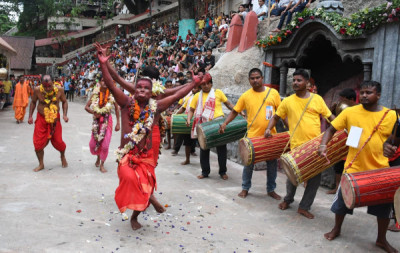Deodhani Dance - The Mystical Folk Dance Of Divine Possession And Ritual Power



Deodhani Dance (also known regionally as Bdeodhani) is one of Assam’s most mystifying and spiritually charged folk dances. Rooted in Shakti worship and serpent goddess Manasa Devi rituals, this unique dance form is performed by women who enter a trance-like state believed to be a form of divine possession. Deodhani is not just a dance—it is a sacred ritual, a spiritual performance, and a cultural treasure of Assam.
The word ‘Deodhani’ translates to “a woman possessed by a deity.” Traditionally, the dance is performed by women believed to be spiritually chosen to serve as mediums of the goddess, particularly Manasa Devi, the serpent goddess associated with protection and fertility.
The Deodhani dance is often performed during Ojapali performances and Than rituals—especially at temples or shrines devoted to goddess Manasa, like the ones in Kamrup, Darrang, and Sonitpur districts.
During the performance, the Deodhani dancer, usually adorned in a white or red saree, carries a sword or ritualistic items and dances vigorously while in a state of trance. The dance is accompanied by the singing of ballads or mantras by Ojapalis (folk singers and drummers), who guide the rhythm and flow of the performance.
The dancer’s movements reflect divine energy, intense emotion, and symbolic gestures that embody the goddess’s presence. It often involves elements of martial arts, storytelling, and ritual invocation, making it both spiritually intense and visually compelling.
The music for Deodhani Dance is integral to the experience. It includes Khol, Taal, Nagada, and Ojapali vocals, which not only provide rhythm but also narrate mythological stories and prayers to invoke divine energy.
The powerful beat and chants help the dancer reach a heightened spiritual state, where she is believed to communicate with or become a vessel of the deity.
Deodhani Dance is one of the rare ritualistic traditions in India that continues to thrive in pockets of Assam, though it is increasingly endangered due to modernization and the decline of oral traditions.
Cultural organizations and folklore academies are working toward preserving and promoting this rare dance form through workshops, festivals, and documentation. It is also showcased during state-sponsored cultural events, such as the Srimanta Sankaradeva Kalakshetra festivals and the National Handloom & Cultural Festivals of Assam.
Conclusion
The Deodhani Dance of Assam is a living expression of the state’s spiritual depth, mythological traditions, and sacred folk heritage. A mesmerizing blend of trance, devotion, and ritual artistry, it invites audiences into the mystical world of goddess worship and cultural continuity. For those seeking an authentic experience of Assam's spiritual landscape, witnessing a Deodhani performance is unforgettable.